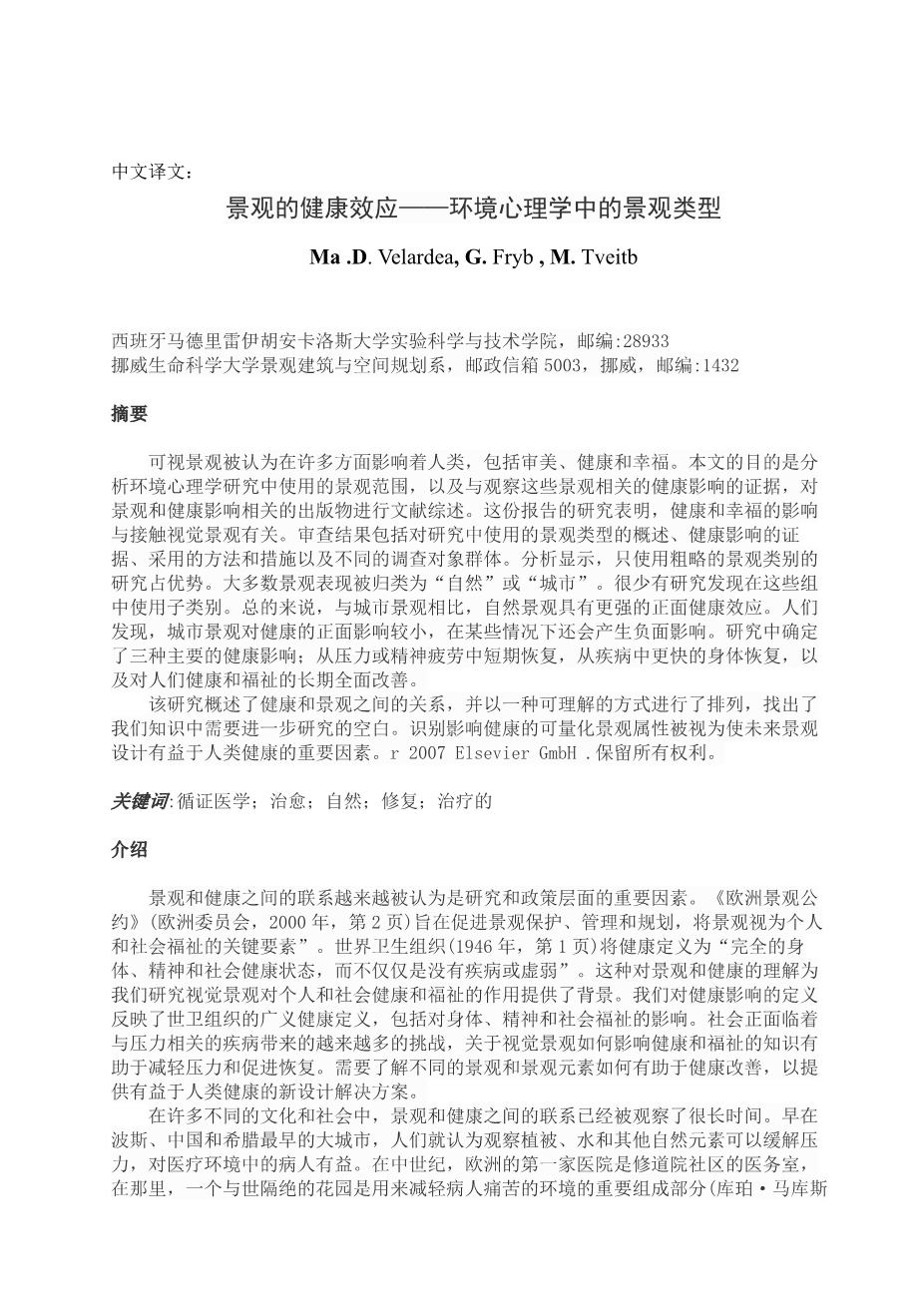“时渡”——南京五马渡滨江公共空间景观改造设计(建筑及周边景观)外文翻译资料
2022-08-06 10:10:19
中文译文:
计算机打印,一律用A4规格复印纸输出。打印中文用宋体小四号字,英文用新罗马体12号字,版面上空2.5cm,下空2cm,左空2.5cm,右空2cm。论文标题用黑体三号字。
附原文:Health effects of viewing landscapes – Landscape types in environmental psychology
Ma .D. Velardea, G. Fryb , M. Tveitb
a School of Experimental Sciences and Technology, Rey Juan Carlos University of Madrid, C/Tulipan s/n, 28933 Moacute;stoles, Madrid, Spain b Department of Landscape Architecture and Spatial Planning, Norwegian University of Life Sciences, PO Box 5003, N-1432 Aas, Norway
Abstract
The visible landscape is believed to affect human beings in many ways, including aesthetic appreciation and health and well-being. The aim of this paper is to analyse the range of landscapes used in environmental psychology studies, and the evidence of health effects related to viewing these landscapes. A literature review of publications linking landscapes and health effects was conducted. This reported evidence of health and well-being effects related to exposure to visual landscapes. The results of the review include an overview of the types of landscape used in the studies, the evidence on health effects, the methods and measures applied and the different groups of respondents. The analysis reveals a predominance of studies using only coarse categories of landscapes. Most landscape representations have been classed as lsquo;lsquo;naturalrsquo;rsquo; or lsquo;lsquo;urbanrsquo;rsquo;. Few studies were found to use subcategories within these groups. Generally, the natural landscapes gave a stronger positive health effect compared to urban landscapes. Urban landscapes were found to have a less positive and in some cases negative effect on health. Three main kinds of health effects have been identified in the study; short-term recovery from stress or mental fatigue, faster physical recovery from illness and long-term overall improvement on peoplersquo;s health and well-being.
The study provides an overview of the relationships between health and landscapes arranged in an accessible format, identifying gaps in our knowledge requiring further research. The identification of quantifiable landscape attributes that affect health is seen as an important factor in enabling future landscape design to be of benefit to human health. r 2007 Elsevier GmbH. All rights reserved.
Keywords: Evidence-based; Healing; Nature; Restoration; Therapeutic
Introduction
The links between landscape and health are increasingly recognized as important in research and at the policy level. The European Landscape Convention (Council of Europe, 2000, p. 2) aims to promote landscape protection, management and planning, considering landscape as a key element of individual and social well-beingrsquo;rsquo;. The World Health Organization (1946, p. 1) defines health as lsquo;lsquo;a state of complete physical, mental and social well-being and not merely the absence of disease or infirmityrsquo;rsquo;. This understanding of landscape and health provides the background for our approach to investigating the evidence for the role of exposure to the visual landscapes for individual and social health and well-being. Our definition of health effects reflects the broad health definition of the WHO, encompassing effects on physical, mental and social well-being. Society is facing increasing challenges with stress-related diseases, and knowledge about the way the visual landscape affects health and well-being can help mitigate stress and increase restoration. Knowledge about how different landscapes and landscape elements contribute to health improvement is needed to provide new design solutions beneficial to human health.
Links between landscape and health have been observed for a long time and in many different cultures and societies. The belief that viewing vegetation, water and other natural elements can ameliorate stress and is beneficial for patients in healthcare environments dates as far back as the earliest large cities in Persia, China and Greece. In the Middle Ages, the first hospitals in Europe were infirmaries in monastic communities where a cloistered garden was an essential part of the environment used to bring relief to the ill (CooperMarcus and Barnes, 1999; Ulrich, 2002).
Through history, the connection between nature and healing was gradually superseded by increasingly technical approaches and the idea that access to nature could assist in healing lost much of its significance (Cooper-Marcus and Barnes, 1999; Ulrich, 2002). However, in the last 25 years these traditional ways of linking nature and health effects have re-emerged as a topic of interest in the field of human health. Research has generated a relatively rich literature to explain the ways in which natural and other environments have an effect on human health.
A range of theories and approaches have been forwarded in order to explain and assess the influence of landscapes on human health. Contemporary theories, such as Ulrichrsquo;s lsquo;lsquo;Stress Recovery Theoryrsquo;rsquo; (Ulrich, 1984, 1999), predict that natural scenes tend to reduce stress, whereas settings in the built environment tend to hinder recovery from stress. Researchers have provided possible explanations for this relationship. Evolutionary theories of landscape preferences explain the benefits of natural scenes as
剩余内容已隐藏,支付完成后下载完整资料

英语译文共 28 页,剩余内容已隐藏,支付完成后下载完整资料
资料编号:[254972],资料为PDF文档或Word文档,PDF文档可免费转换为Word




